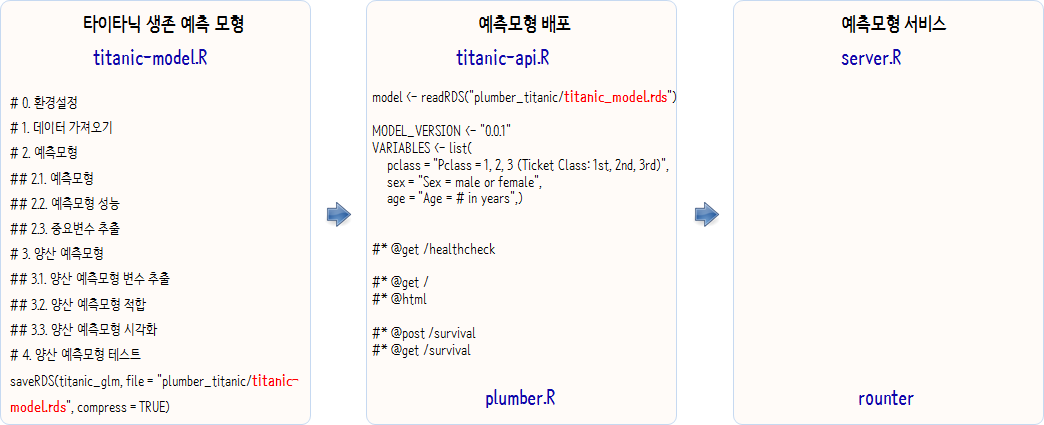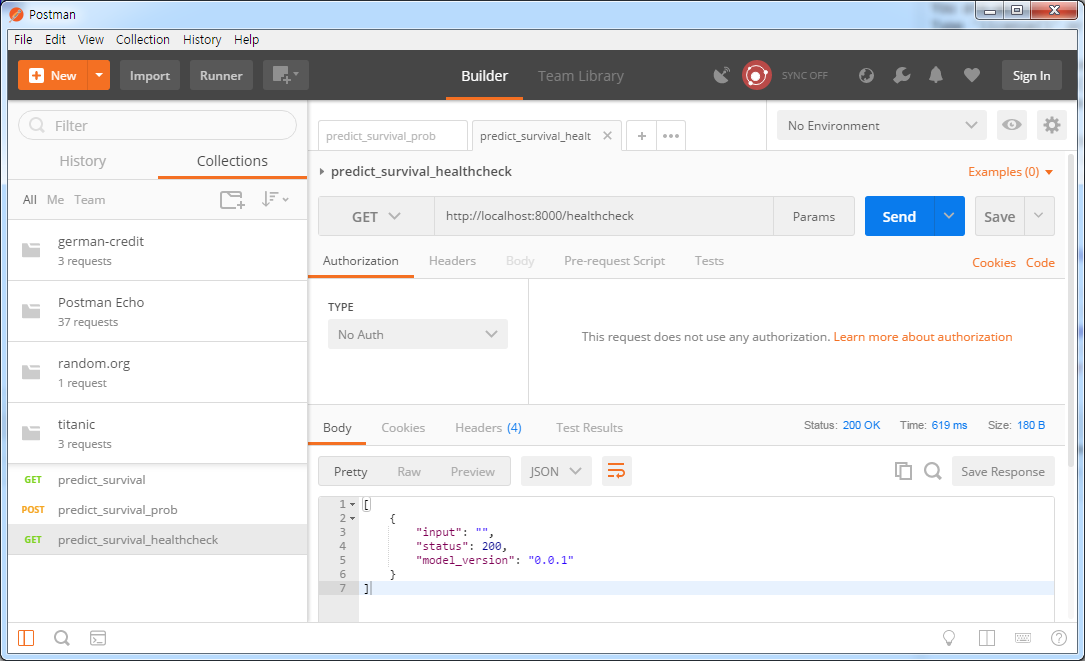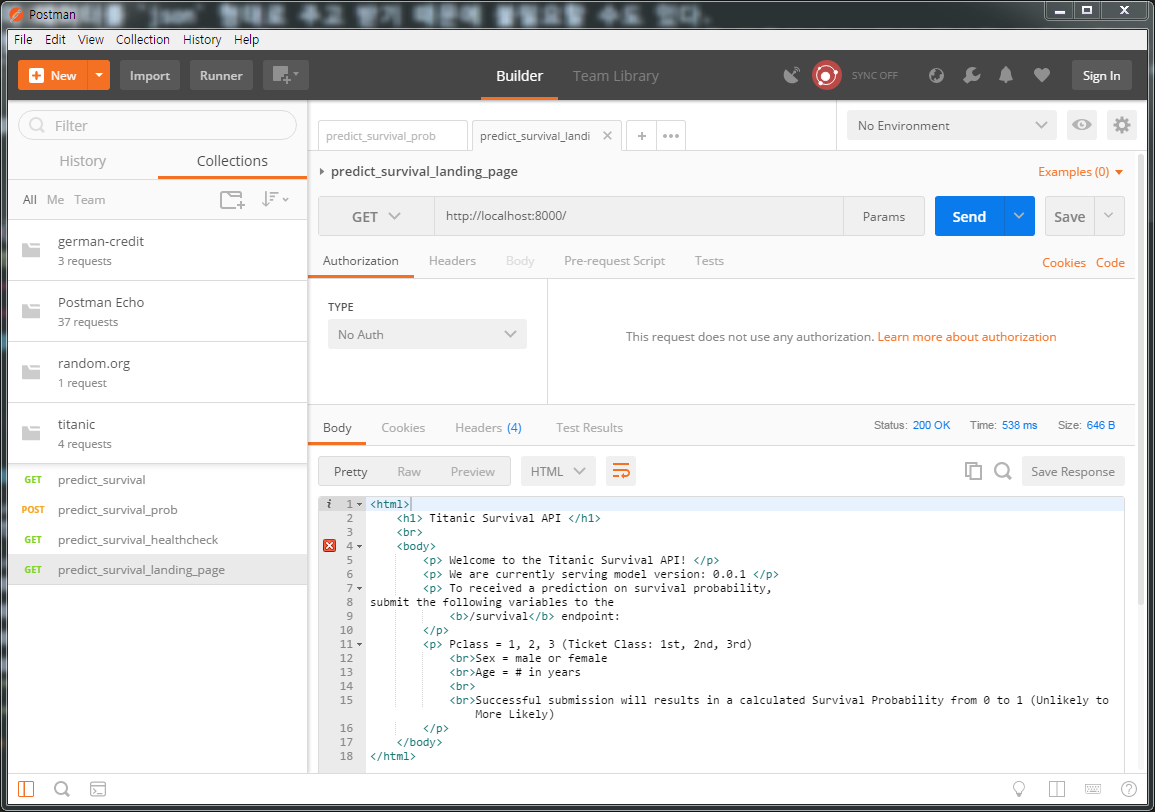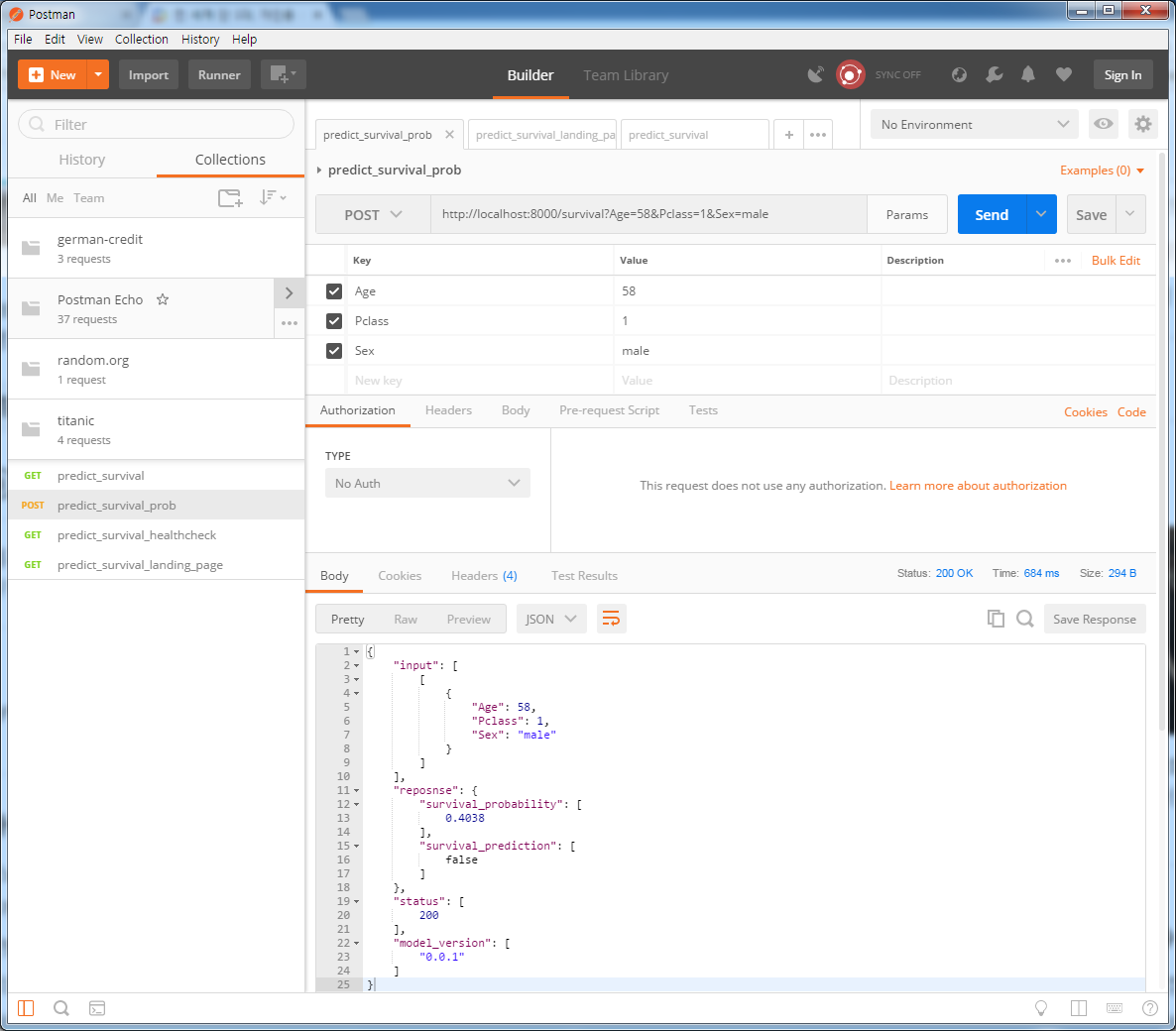R 병렬 프로그래밍
R 양산환경(plumber) - 타이타닉
타이타닉 생존 확률 예측 서비스 1
기본적으로 서비스로 관심이 있는 것은 타이타닉호에 승선했을 때, 나이, 호실, 성별 등 기본정보를 입력했을 때 생존확률이 얼마인지 알려주는 서비스를 제공하는 것이다. 결국 예측모형을 .RData, .rds 파일로 저장하면 RESTful API 서비스를 plumber.R 혹은 titanic-api.R 파일에 기술한다. 통상 끝점(endpoint) 서비스를 기술한다.
#* @get /healthcheck#* @get /#* @html#* @post /survival#* @get /survival
반면에, rounter 혹은 server.R 파일에는 암화화 쿠기, 오류 처리 등을 포함하여 서비스를 제공한다.

타이타닉 생존 모형
캐글 타이타닉 데이터를 다운로드 받아 생존 예측모형을 제작한다.
# 0. 환경설정 -------------------
library(tidyverse)
# 1. 데이터 불러오기 -------------------
titanic_dat <- read_csv("data/titanic-train.csv")
# 2. 데이터 전처리 -------------------
transform_titantic_data <- function(input_titantic_data) {
ouput_titantic_data <- data_frame(
survived = factor(input_titantic_data$Survived, levels = c(0, 1)),
pclass = factor(input_titantic_data$Pclass, levels = c(1, 2, 3)),
female = tolower(input_titantic_data$Sex) == "female",
age = factor(dplyr::if_else(input_titantic_data$Age < 18, "child", "adult", "unknown"),
levels = c("child", "adult", "unknown"))
)
return(ouput_titantic_data)
}
titanic_df <- transform_titantic_data(titanic_dat)
# 3. 예측모형 -------------------
training_rows <- sample(1:nrow(titanic_df), size = floor(0.7*nrow(titanic_df)))
train_df <- titanic_df[training_rows, ]
test_df <- titanic_df[-training_rows, ]
titanic_glm <- glm(survived ~ pclass + female + age,
data = titanic_df,
family = binomial(link = "logit"))
# 4. 모형성능 평가 -------------------
test_predictions <- predict(titanic_glm, newdata = test_df, type = "response") >= 0.5
test_actuals <- test_df$survived == 1
accuracy <- table(test_predictions, test_actuals)
print(accuracy)
print(paste0("Accuracy: ", round(100 * sum(diag(accuracy))/sum(accuracy), 2), "%"))
# 5. 예측모형 배포 -------------------
saveRDS(titanic_glm, file = "plumber_titanic/titanic-model.rds", compress = TRUE)생존확률 RESTful API 서비스 건강상태 체크
가장 먼저 R에서 개발한 titanic-model.rds를 가져온다. 그리고 나서, 모형 버젼 MODEL_VERSION, 입력변수 VARIABLES, RESTful API 서비스로 제공하는 값에 대해 기술한다.
다음으로 HTTP GET 요청으로 RESTful API가 정상 동작하는지 건강상태 확인 http://127.0.0.1:8000/healthcheck을 가장 먼저 수행한다.
library(plumber)
model <- readRDS("plumber_titanic/titanic-model.rds")
MODEL_VERSION <- "0.0.1"
VARIABLES <- list(
pclass = "Pclass = 1, 2, 3 (Ticket Class: 1st, 2nd, 3rd)",
sex = "Sex = male or female",
age = "Age = # in years",
gap = "",
survival = "Successful submission will results in a calculated Survival Probability from 0 to 1 (Unlikely to More Likely)")
#* @get /healthcheck
health_check <- function() {
result <- data.frame(
"input" = "",
"status" = 200,
"model_version" = MODEL_VERSION
)
return(result)
}
생존확률 RESTful API 서비스 홈페이지
기계와 기계 사이에 데이터를 json 형태로 주고 받기 때문에 불필요할 수도 있다. 하지만, 제3자가 봤을 때 혹시 필요한 경우가 있어 방문 페이지(landing page)를 만들어 놓는 것이 필요한 경우도 있다. 데코레이터 @get 아래 @html을 사용하게 되면 json 대신에 html을 반환하게 되어 방문 웹페이지를 깔끔하게 구축할 수 있다.
#* @get /
#* @html
home <- function() {
title <- "Titanic Survival API"
body_intro <- "Welcome to the Titanic Survival API!"
body_model <- paste("We are currently serving model version:", MODEL_VERSION)
body_msg <- paste("To received a prediction on survival probability,",
"submit the following variables to the <b>/survival</b> endpoint:",
sep = "\n")
body_reqs <- paste(VARIABLES, collapse = "<br>")
result <- paste(
"<html>",
"<h1>", title, "</h1>", "<br>",
"<body>",
"<p>", body_intro, "</p>",
"<p>", body_model, "</p>",
"<p>", body_msg, "</p>",
"<p>", body_reqs, "</p>",
"</body>",
"</html>",
collapse = "\n"
)
return(result)
}
생존확률 RESTful API 끝점(endpoint)
예측 서비스를 끝점(endpoint)을 통해서 바로 제공하기 전에 transform_titantic_data() 함수와 validate_feature_inputs() 함수를 통해서 예측서비스 입력에 대해서 먼저 점검 작업을 수행한다. 특히, validate_feature_inputs() 함수는 입력 변수에 대해 논리 테스트를 수행하여 모든 것이 이상이 없다면 “OK”를 결과값으로 반환시킨다.
@post, @get 방식으로 /survival 끝점을 통해서 predict_survival 함수로 산출된 생존확률값을 제공한다.
transform_titantic_data <- function(input_titantic_data) {
ouput_titantic_data <- data.frame(
pclass = factor(input_titantic_data$Pclass, levels = c(1, 2, 3)),
female = tolower(input_titantic_data$Sex) == "female",
age = factor(dplyr::if_else(input_titantic_data$Age < 18, "child", "adult", "unknown"),
levels = c("child", "adult", "unknown"))
)
}
validate_feature_inputs <- function(age, pclass, sex) {
age_valid <- (age >= 0 & age < 200 | is.na(age))
pclass_valid <- (pclass %in% c(1, 2, 3))
sex_valid <- (sex %in% c("male", "female"))
tests <- c("Age must be between 0 and 200 or NA",
"Pclass must be 1, 2, or 3",
"Sex must be either male or female")
test_results <- c(age_valid, pclass_valid, sex_valid)
if(!all(test_results)) {
failed <- which(!test_results)
return(tests[failed])
} else {
return("OK")
}
}
#* @post /survival
#* @get /survival
predict_survival <- function(Age=NA, Pclass=NULL, Sex=NULL) {
age = as.integer(Age)
pclass = as.integer(Pclass)
sex = tolower(Sex)
valid_input <- validate_feature_inputs(age, pclass, sex)
if (valid_input[1] == "OK") {
payload <- data.frame(Age=age, Pclass=pclass, Sex=sex)
clean_data <- transform_titantic_data(payload)
prediction <- predict(model, clean_data, type = "response")
result <- list(
input = list(payload),
reposnse = list("survival_probability" = prediction,
"survival_prediction" = (prediction >= 0.5)
),
status = 200,
model_version = MODEL_VERSION)
} else {
result <- list(
input = list(Age = Age, Pclass = Pclass, Sex = Sex),
response = list(input_error = valid_input),
status = 400,
model_version = MODEL_VERSION)
}
return(result)
}
특히, 훌륭한 RESTful API를 설계하기 위한 지침을 참조하여 활용하는 것도 권장된다. 2
